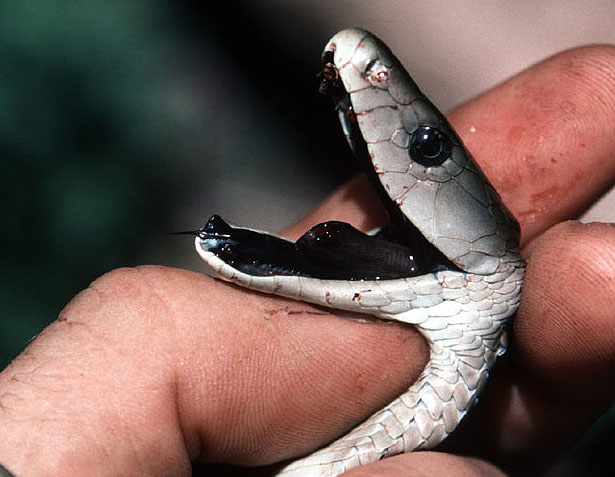KING COBRA The King Cobra (Ophiophagus hannah) is the world's longest venomous snake, with a length up to 5.6 m (18.5 ft). This species is widespread throughout Southeast Asia and parts of India, and is found mostly in forested areas. The King cobra is not a kind of cobra at all; it belongs to its own genus. It can be identified from other cobras by its size and the pattern on its neck. King cobras are larger than other cobras, and the stripe on its neck is like the symbol, instead of a double or single eye shape that may be seen in other cobras. King cobra's genus name, Ophiophagus, literally means "snake-eater", and its diet consists primarily of other snakes, including rat snakes, sizeable pythons and even other venomous snakes (including kraits, cobras and smaller members of its own species). The venom of the King Cobra is primarily neurotoxic, and the snake is fully capable of killing a human with a single bite. The mortality rate from a bite can be as high as 75%, or as low as 33%, depending upon treatment details. These snakes have a reputation of being one of the most dangerous asiatic snakes. |
BOA CONSTRICTOR The Boa constrictor (Boa constrictor) is a large, heavy-bodied species of snake. It is a member of the Boidae family found in Central America, South America and some islands in the Caribbean. A staple of private collections and public displays, its color pattern is highly variable yet distinctive. Ten subspecies are currently recognized, although some of these are controversial. This article focuses on the species Boa constrictor as a whole, but also specifically on the nominate subspecies Boa constrictor constrictor. Though all boids are constrictors, only this species is properly referred to as "Boa constrictor"; an almost unique instance of an animal having the same common and scientific binomial name. (The distinction is shared with Tyrannosaurus rex.) All subspecies are referred to as "boa constrictors," while the nominate subspecies, B. c. constrictor, is often referred to specifically as the "red-tailed boa." Within the exotic pet trade it is also known as a "BCC", an abbreviation of its scientific name, to distinguish it from other Boa constrictor subspecies such as the Boa constrictor imperator which is also regularly, and erroneously, referred to as a "red-tailed boa." Other common names include "jibóia" (Latin American) and "macajuel" (Trinidadian, pronounced mah-cah-well). http://en.wikipedia.org/wiki/Boa_constrictor
|
BLACK MAMBA The black mamba (Dendroaspis polylepis) is the largest venomous snake in Africa, with an average length around 8 feet (2.5 m), but may grow to 14 feet (4.3 m). It got its name because of the black inside of its mouth; the actual color of the skin is varied: dull yellowish-green to a gun-metal grey. It is one of the fastest snakes in the world, capable of moving at 10 to 12 mph (16 to 20 km/h). The snake is classified under the the name Dendroaspis polylepis. Dendroaspis refers to the fast-moving land snakes of Africa. It literally means "tree snake." The latin term polylepis refers to the genus of trees, of which, the black mamba dwells. The name "black mamba" is given to the snake not because of its body color but because of its ink black mouth.http://en.wikipedia.org/wiki/Black_mamba |  |
 | BALL PYTHONS Python regius is a non-venomous python species found in Africa. This is the smallest of the African pythons and is popular in the pet trade. No subspecies are currently recognized. The name ball python refers to the animal's tendency to curl into a ball when stressed or frightened. The name royal python (from the Latin "regius") is based in part on the story that Cleopatra supposedly wore the snake around her wrist. Adults generally do not grow to more than 90–120 cm (3.0–3.9 ft) in length, although some specimens have reached 152 cm and even 182 cm (5–6 feet), but this is very rare. Females tend to be slightly bigger than males maturing at an average of 4-4.5 feet. Males usually average around 3-3.5 feet. The build is stocky while the head is relatively small. The scales are smooth and both sexes have anal spurs on either side of the vent. Although males tend to have larger spurs, this is not definitive, and sex is best determined via manual eversion of the male hemipenes or inserting a probe into the cloaca to find the inverted hemipenes (if male). |